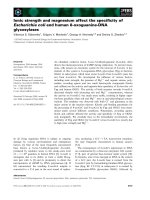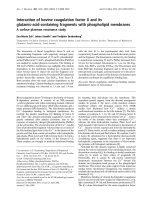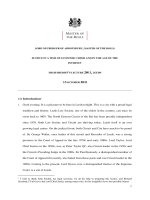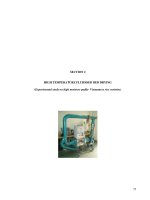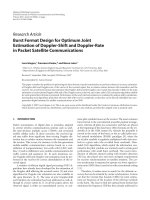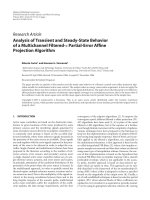Static strength of fabricated trunnion and x joint under shear and in plane bending moment
Bạn đang xem bản rút gọn của tài liệu. Xem và tải ngay bản đầy đủ của tài liệu tại đây (1.26 MB, 60 trang )
STATIC STRENGTH OF FABRICATED TRUNNION &
X-JOINT UNDER SHEAR AND IN-PLANE BENDING MOMENT
QUAH CHIN KAU
NATIONAL UNIVERSITY OF SINGAPORE
2006
STATIC STRENGTH OF FABRICATED TRUNNION AND
X-JOINT UNDER SHEAR AND IN-PLANE BENDING MOMENT
BY
QUAH CHIN KAU, M.Eng., B.Eng.(Hons)
DEPARTMENT OF CIVIL ENGINEERING
A THESIS SUBMITTED
FOR THE DEGREE OF DOCTOR OF PHILOSOPHY
NATIONAL UNIVERSITY OF SINGAPORE
2006
To God Be the Glory
i
ACKNOWLEDGEMENTS
I would like to express my sincere appreciation to my supervisors, Professor N. E.
Shanmugam, Associate Professor Choo Yoo Sang and Associate Professor Richard Liew
Jat Yuen for their invaluable support, guidance and encouragement throughout the course
of this study.
Special thanks also to the staff from the former CAE/CAD/CAM Centre and Civil &
Structural Engineering Laboratory, Faculty of Civil Engineering, for their help and
support in the computational and experimental investigations respectively.
I also gratefully acknowledge the National Science & Technology Board, Singapore
(NSTB), Sembawang Marine & Offshore Engineering (SMOE) and the National
University of Singapore (NUS) for providing the necessary finances, equipment and
research facilities to pursue the study.
It was my mother, who struggled hard to put me through many years of education, that has
the strongest desire to see her son succeed. I dedicate this volume to her: for her untiring
perseverance, patience and believe in her son.
Last, but not the least, my dear wife, who makes the journey during the course of the
study more bearable and enjoyable.
Everything is made possible by the grace of God.
ii
TABLE OF CONTENTS
ACKNOWLEDGEMENTS …………………………… …….… …………… i
TABLE OF CONTENTS ………………………… ………….… …………… ii
SUMMARY ………………………………………… ……….… …………… viii
LIST OF TABLES …………………………………………….… …………… xi
LIST OF FIGURES ……………………………………… ….… …………… xiii
LIST OF SYMBOLS ………………………………………….… …………… xx
CHAPTER ONE INTRODUCTION
1.1 Structural applications of hollow sections and trunnions ……… 1
1.2 Types of trunnions studied ……………………… …………… 8
1.3 Classification of joints ………………………………… ……. 14
1.4 Objectives and scope of research ……………………………… 16
1.5 Survey of previous research …………………………………… 19
1.5.1 Experimental research in trunnion …………………… 21
1.5.2 Research in tubular X-joints …………………….…… 25
1.5.3 Finite element method …………………………….…… 29
1.6 Current design recommendations ……………………………… 31
1.7 Contents of Thesis …………………………………………… 35
CHAPTER TWO EXPERIMENTAL INVESTIGATION ON SMALL PIPE
TRUNNIONS
2.1 Introduction ……………………………………………………. 36
2.2 Research programme ………………………………………… 38
iii
2.2.1 Trunnion dimensions … … … … … … … … … … … … … 38
2.2.2 Fabrication of specimen … … … … … … … … … … … … . 41
2.2.3 6,000kN test rig … … … … … … … … … … … … … … … . 44
2.2.4 Instrumentation … … … … … … … … … … … … … … … 46
2.3 Governing failure mode of trunnion … … … … … … … … … … 48
2.3.1 Pure pipe trunnions … … … … … … … … … … … … … … . 48
2.3.2 Shear plate pipe trunnions … … … … … … … … … … … 51
2.3.3 Combined shear and pipe trunnions … … … … … … … … 54
2.4 Discussions of the test results … … … … … … … … … … … … … 58
2.4.1 Design strength pure pipe trunnions … … … … … … .… 58
2.4.2 Design strength of pipe trunnions with slotted shear
plates only … … … … … … … … … … … … … … … … … … 62
2.4.3 Design strength of pipe trunnions with shear plates
and pipes … … … … … … … … … … … … … … … … … … 65
2.5 Conclusions … … … … … … … … … … … … … … … … … … … … 67
CHAPTER THREE EXPERIMENTAL INVESTIGATION OF LARGE PIPE
TRUNNIONS AND TUBULAR X-JOINTS
3.1 Introduction … … … … … … … … … … … … … … … … … … … … 69
3.2 Research Programme … … … … … … … … … … … … … … … … 71
3.2.1 Trunnion dimensions … … … … … … … … … … … … … 71
3.2.2 Fabrication of specimen for test … … … … … … … … … . 75
3.2.3 10,000kN test rig … … … … … … … … … … … … … … … 77
3.2.4 Instrumentation … … … … … … … … … … … … … … … 87
3.3 Governing failure mode of trunnion … … … … … … … … … … 90
3.3.1 Pure pipe trunnion … … … … … … … … … … … … … … . 90
iv
3.3.2 Through pipe trunnion … … … … … … … … … … … … … 95
3.3.3 Combined shear plate and pipe trunnion … … … … … … 97
3.3.4 Tubular X-joints … … … … … … … … … … … … … … … . 101
3.4 Discussions of the test results … … … … … … … … … … … … … . 105
3.4.1 Design strength of pure pipe trunnions … … … … .… … 105
3.4.2 Design strength of through pipe trunnions … … … … 110
3.4.3 Design strength of combined shear plate and
pipe trunnions … … … … … … … … … … … … … … … .… 113
3.4.4 Transition of shear and bending moment … … … … … … 116
CHAPTER FOUR FINITE ELEMENT ANALYSES ON TUBULAR JOINTS
4.1 Introduction … … … … … … … … … … … … … … … … … … … … . 120
4.2 Finite element programs and hardware used … … … … … … … 122
4.3 Main characteristics of finite element work on tubular joints … 123
4.3.1 Finite element mesh and boundary conditions … … … … 123
4.3.2 Finite element types … … … … … … … … … … … … … … 125
4.3.3 Loading of the joints … … … … … … … … … … … … … 127
4.3.4 Modeling of the post-yield material property … … … … . 128
4.3.5 Iteration procedure and convergence criteria … … … … 129
4.3.6 Numerical modeling of weld geometry … … … … .… … 130
4.4 Numerical analysis for the experimental tests … … … … … … … . 131
CHAPTER FIVE NUMERICAL SIMULATION OF THE EXPERIMENTS
5.1 Research programme and general finite element aspects … … … 134
5.2 Numerical analyses … … … … … … … … … … … … … … … … … . 135
v
5.2.1 Pure pipe trunnions . … … … … … … … … … … … .… … . 137
5.2.2 Shear plate pipe trunnions .… … … … … … … … … … … 140
5.2.3 Through pipe trunnions … … … … … … … … … … … 141
5.2.4 Combined shear plate and pipe trunnions … … … … … . 143
5.2.5 Shear and bending loads on tubular X-joints … … … … 145
5.3 Comparison between the experimental and numerical results 146
5.3.1 Pure pipe trunnions … … … … … … … … … … … … … 147
5.3.2 Shear plate pipe trunnions … … … .… … … … … … … .… 151
5.3.3 Through pipe trunnions … .… … … … .… … … .… … … 152
5.3.4 Combined shear plate and pipe trunnions … … … … .… . 154
5.3.5 Shear and bending loads on tubular X-joints … … … … 156
CHAPTER SIX NUMERICAL PARAMETRIC STUDIES
6.1 Assumptions for the numerical models … … … … … … … … … . 159
6.2 Pure pipe trunnions … .… … … … … … … … … … … … … … … 161
6.2.1 Research programme … … … … … … … … … … … … … . 162
6.2.2 Effective W ratio for trunnion design … … … … … … .… . 170
6.2.3 Effective E ratio for trunnion design … … … … … … … . 179
6.2.4 Selection and design approach for pure pipe trunnions 186
6.2.5 Proposed design formulation for pipe trunnions .… … 194
6.3 Through pipe trunnions … … … … … … … … … … … … … … … 196
6.3.1 Research programme … … … … … … … … … … … … … . 197
6.3.2 Comparison of ultimate load capacity of through pipe
trunnions … … .… … … … … … … … … … … … … … … . 201
6.3.3 Design approach of through pipe trunnions … … … … . 205
vi
6.4 Tubular X-joints … … … … … … … … … … … … … … … … … … . 208
6.4.1 Research Programme … … … … … … … … … … … … … 208
6.4.2 Interaction effects of shear and bending moment … .… 209
6.4.3 Proposed interaction equation of shear and
bending moment … … … … … … … … … … … … … … … . 211
6.4.4 Effective width of trunnion brace … … … … … … … … … 216
CHAPTER SEVEN TRUNNION DESIGN CALCULATION
7.1 Design approach for fabricated trunnion … … … … … … … … … . 218
7.2 Rigging arrangement and design loads … … … … … … … … … … 220
7.3 Estimating lifting loads on the trunnion .… … … .… … … … … … . 220
7.4 Pure pipe trunnion option … … … … … … … … … … … … … … … . 221
7.4.1 Selection of pure pipe trunnion … … … … … … … … … … 222
7.4.2 Verifying chord and brace sizes … … … … … … … … … 224
7.5 Through pipe trunnion option … … … … … … … … … … … … … 227
7.5.1 Selection of chord and brace sizes … … … … … … … … 227
7.6 Combined pipe and shear plate trunnion option … … … … … … 230
7.6.1 Design load considerations and layout … … … … … … … . 231
7.6.2 Selection of main parameters … … … … … … .… … … … 234
7.6.3 Checks for trunnion brace … … … … … … … … … … … . 235
7.6.4 Checks for shear plate … … … … … … … … .… … … … 237
7.6.5 Checks for chord wall … … … … … … … … … … … … … 239
7.7 Conclusions … … … … … … … … … … … … … … … … … … … … 240
vii
CHAPTER EIGHT CONCLUSIONS AND RECOMMENDATIONS FOR
FUTURE WORK
8.1 Overview of experimental study … … … … … … … … … … … … 241
8.2 Overview of numerical and parametric study … … … … … … … 243
8.3 Overview of trunnion calculations … … … … … … … … … … … 244
8.4 Main findings and conclusions … … … … … … … … … … … … … 244
8.5 Proposals for future research … … … … … … … .… … … … … … 248
REFERENCES … … … … … … … … … … … … … … … … … … … … … … … … 250
viii
SUMMARY
Current design receommendations define fabricated trunnions as consisting of a
slotted shear plate and two side braces on each side of a main body. It is used as a
lifting point in the installation of heavy offshore structures. There is very limited
experimental and numerical work that has been conducted to study the behaviour and
strength of trunnion subjected to shear and bending moment. As a result, current
design recommendations for trunnion cover generic specifications on the geometric
dimensions only. Further, it does not include brace shear strength as contributing to
the overall static strength of a trunnion joint. Thus, current trunnion joint design
practice is very conservative. The detailed engineering designs for trunnion are
empirical and dependent on the ingenuity of experienced engineers using empirical
equations for design checks. This creates a big gap in the understanding of behaviour
and strength of trunnion subjected to shear and bending moment.
The objective of this study is to close the gap and provide a more rational design
approach through a comprehensive experimental and numerical research programme.
There is a three fold approach used in this study. The experimental programme
provides the basis in benchmarking the ultimate strength of trunnion. Numerical
analysis extends the validity range possible through tests. An analytical design
approach is proposed based on experimental and numerical results. The definition of
fabricated trunnion has been expanded to include pure pipe trunnion and through pipe
trunnion while considering the shear strength contribution from brace.
ix
Due to the difficult nature of the test in simulating the behaviour of the trunnion
subjected to shear and bending moment, two experimental setup were performed.
Twenty five large scale specimens were tested, majority on a completely new and
specially designed test rig that were capable of testing trunnion to failure without the
use of a grommet. The use of grommet in the experiments posed many challenges and
limits the scale of specimens that can be tested. The results obtained provide
significant knowledge on the ultimate failure behaviour of trunnion.
The large database from the experimental tests provide sufficient and valuable
information to calibrate the numerical models. Finite element models were created to
simulate the ultimate failure behaviour of the tests. There is good agreement between
the experimental and numerical results and they provide the basis in performing an
extensive numerical research programme on three types of trunnion.
The results were collated and analysed. The results have proven that the brace
contributes significantly to the static strength of the trunnion. An analytical approach
to the trunnion design provides a complete table where pure pipe trunnion could be
selected where failure mode is governed by shear and not chord indentation. A new
approach was also introduced in using through pipe trunnion that extends the
boundary by reducing the effects of chord indentation so that full static strength of the
trunnion joint can be mobilized. In addition, an interaction equation was proposed
based on regression analysis of the results. The allowable trunnion width is
established.
x
An example trunnion design calculations was presented to highlight the practical
nature of the proposed design approach that is applicable to the industry. Three
different design approaches were used and their relative merits compared.
xi
LIST OF TABLES
Table 2.1 Small pipe trunnion dimensions and non-dimensional geometric
parameters
Table 2.2 Summary of the ultimate loads and displacement for specimen C1 to
CT8
Table 2.3 Summary of the ultimate loads and displacement for specimen C1 to
C3
Table 2.4 Summary of the ultimate loads and displacement for specimen C4 &
C5
Table 2.5 Summary of the ultimate loads and displacement for specimen C6 to
C8
Table 3.1 Large pipe trunnion dimensions and non-dimensional geometric
parameters
Table 3.2 Summary of the ultimate loads and displacement for specimens CT1 to
CT5
Table 3.3 Summary of the ultimate loads and displacement for specimens CT6
and CT7
Table 3.4 Summary of the ultimate loads and displacement for specimens CT8 to
CT11
Table 3.5 Summary of the ultimate loads and displacement for specimens CT12
to CT17
Table 3.6 Summary of the ultimate and design strength for CT1 to CT5
Table 3.7 Summary of the ultimate and design strength for CT8 to CT11
Table 5.1 Research programme for the numerical analysis
Table 6.1 Research programme of pure pipe trunnions (in plane only)
Table 6.2 Dimensions and non-dimensional geometric parameters for W = 0.46,
0.28 < E < 0.90, 10 < 2J <30
Table 6.3 Dimensions and non-dimensional geometric parameters for W = 0.75,
0.28 < E < 0.90, 10 < 2J <30
xii
Table 6.4 Dimensions and non-dimensional geometric parameters for W = 1.00,
0.28 < E < 0.90, 10 < 2J <30
Table 6.5 Dimensions and non-dimensional geometric parameters for W = 1.25,
0.28 < E < 0.90, 10 < 2J <30
Table 6.6a Results of the ultimate load capacity for pipe trunnions
Table 6.6b Results of the ultimate load capacity for pipe trunnions
Table 6.7 Results of the ultimate load capacity for test pipe trunnions
Table 6.8 Failure modes of pipe trunnions based on non-geometric parameters
Table 6.9 Dimensions and non-dimensional geometric parameters for through
pipe trunnions
Table 6.10 Comparison of static strength with and without through pipe for 2J =
30
Table 6.11 Comparison of static strength with and without through pipe for E =
0.70
Table 6.12 Governing failure mode of through pipe trunnions
Table 6.13 Dimensions and non-dimensional geometric parameters for X-joints
Table 6.14 Shear and bending moment interaction from the numerical and
experimental results
Table 7.1 Failure mode of pure pipe trunnions
Table 7.2 Failure mode of through pipe trunnions
xiii
LIST OF FIGURES
Figure 1.1 An effective use of a fabricated plate trunnions to transfer the loads
through a spreader beam for the lifting of a heavy topside module
Figure 1.2 A fabricated pipe trunnion installed at an inclined position to transfer
the loads through a single lifting point for the lifting of a heavy topside
module
Figure 1.3 The installation of a topside above a platform by Heerema DB101
barge crane using fabricated pipe trunnions
Figure 1.4 The installation of a large offshore package requires fabricated pipe
trunnions during an upending operation
Figure 1.5 The diagram above shows a typical trunnion reinforced with a stiffener
to enhance its carrying capacity for lifting operation
Figure 1.6 A typical standard trunnion with a single brace attached to a chord
Figure 1.7 Grommet (wire ropes) placed on both side of the trunnion during a
lifting operation
Figure 1.8 The shear plate is inserted through the chord with the two-halves of the
brace welded over it
Figure 1.9 The shear plate is inserted through the chord and welded on both sides
of the chord but the brace is not welded on the chord
Figure 1.10 Brace inserted through the chord wall and welded on both sides of the
chord
Figure 1.11 Configuration and dimensions of specimen of small pipe trunnion
Figure 1.12 Configuration and dimensions of specimen of large pipe trunnion
Figure 1.13 Recommended geometrical parameters for trunnion, Brown & Root
(1990)
Figure 2.1 An elongated slot hole is made on the chord wall of the trunnion to
accommodate the shear plate
Figure 2.2 A typical fabricated small pipe trunnion for test
Figure 2.3 Tensile coupon for plates and pipes
Figure 2.4 Test arrangement for small pipe trunnion (6000kN test rig)
xiv
Figure 2.5 Loading Condition for 6000kN Test Rig
Figure 2.6 Support Condition for 6000kN Test Rig
Figure 2.7 Placements of transducer at top of chord
Figure 2.8 Placements of transducer at bottom of chord
Figure 2.9 Shear failure on specimen C1
Figure 2.10 Shear failure on specimen C2
Figure 2.11 Chord plastification and fracture on chord of specimen C3
Figure 2.12 Load deformation curves for specimens C1, C2 & C3
Figure 2.13 Shear failure on specimen C4
Figure 2.14 Shear failure on specimen C5
Figure 2.15 Load deformation curves for specimens C4 & C5
Figure 2.16 Shear failure on specimen C6
Figure 2.17 Shear failure on specimen C7
Figure 2.18 Shear failure on specimen C8
Figure 2.19 Load deformation curves for specimens C6, C7 & C8
Figure 2.20 Ultimate loads and shear capacity of specimens C1, C2 & C3
Figure 2.21 Ultimate loads and shear capacity of specimens C4 & C5
Figure 2.22 Ultimate loads and shear capacity of specimens C6 to C8
Figure 3.1 The process of cutting brace to shape and welding on the chord
Figure 3.2 The process of cutting hole on the chord and slotting the brace through
the chord before being butt welded together
Figure 3.3 The shear plate slotted through the vertical hole made on the chord and
the brace overlapping around the shear plate
Figure 3.4 The length of the brace of the tubular X-joints as compared to the
normal trunnion where the brace arm is very short
Figure 3.5 A typical fabricated large pipe trunnion for test
xv
Figure 3.6 A schematic isometric view of the 10,000kN test rig
Figure 3.7 Foundation support for the 10,000kN test rig with interconnecting
sections to provide a self actuating effect on the loading method
Figure 3.8 The loadings from the actuator is transmitted through the half spherical
ball to reduce bending effect from the loading end
Figure 3.9 Loading condition for 10,000kN test rig
Figure 3.10 Key feature of the 10,000kN test rig consists of rotating saddle and
roller support
Figure 3.11 Support condition for 10,000kN test rig
Figure 3.12 Test Arrangement for large pipe trunnion (10,000kN test rig)
Figure 3.13 Placement of transducer in a typical specimen
Figure 3.14 Placement of transducer in a typical specimen
Figure 3.15 Deformation and governing failure mode of specimen CT1
Figure 3.16 Deformation and governing failure mode of specimen CT2
Figure 3.17 Deformation and governing failure mode of specimen CT3
Figure 3.18 Deformation and governing failure mode of specimen CT4
Figure 3.19 Deformation and governing failure mode of specimen CT5
Figure 3.20 Load deformation curves for specimens CT1 to C5
Figure 3.21 Deformation and governing failure mode of specimen CT6
Figure 3.22 Deformation and governing failure mode of specimen CT7
Figure 3.23 Load deformation curves for specimens CT6 and CT7
Figure 3.24 Deformation and governing failure mode of specimen CT8
Figure 3.25 Deformation and governing failure mode of specimen CT9
Figure 3.26 Deformation and governing failure mode of specimen CT10
Figure 3.27 Deformation and governing failure mode of specimen CT11
xvi
Figure 3.28 Load deformation curves for specimens CT8 to CT11
Figure 3.29 Deformation and governing failure mode of specimen CT12
Figure 3.30 Deformation and governing failure mode of specimen CT13
Figure 3.31 Deformation and governing failure mode of specimen CT14
Figure 3.32 Deformation and governing failure mode of specimen CT15
Figure 3.33 Deformation and governing failure mode of specimen CT16
Figure 3.34 Deformation and governing failure mode of specimen CT17
Figure 3.35 Load deformation curves for specimens CT12 to CT17
Figure 3.36 Design load for specimens CT1 to CT4
Figure 3.37 Design load for specimen CT5
Figure 3.38 Design load for specimens CT6 and CT7
Figure 3.39 Comparison load deformation plots for CT2 & CT6 and CT4 & CT7
Figure 3.40 Load deformation curves for specimens CT8 to CT11
Figure 3.41 Load deformation curves for specimens CT12 to CT15
Figure 3.42 Load deformation curves for specimens CT16 to CT17
Figure 3.43 Comparison of the two series of load deformation plots
Figure 4.1 Quarter model of small pipe trunnion with boundary conditions shown
Figure 4.2 Quarter model of large pipe trunnion with boundary conditions shown
Figure 4.3 Effect of mesh on the finite element results
Figure 4.4 Solid model of trunnion compared with test specimen C1 at failure
Figure 4.5 Solid model of trunnion compared with test specimen C5 at failure
Figure 5.1 Comparison of experimental and numerical results of the ultimate
failure mode of small pipe trunnion C1
Figure 5.2 Comparison of experimental and numerical results of the ultimate
failure mode of small pipe trunnion C3
xvii
Figure 5.3 Comparison of experimental and numerical results of the ultimate
failure mode of small pipe trunnion CT3
Figure 5.4 Comparison of experimental and numerical results of the ultimate
failure mode of small pipe trunnion CT5
Figure 5.5 Comparison of experimental and numerical results of the ultimate
failure mode of shear plate small pipe trunnion C5
Figure 5.6 Comparison of experimental and numerical results of the ultimate
failure mode of shear plate small pipe trunnion CT6
Figure 5.7 Comparison of experimental and numerical results of the ultimate
failure mode of shear plate small pipe trunnion CT7
Figure 5.8 Comparison of experimental and numerical results of the ultimate
failure mode of shear plate small pipe trunnion CT10
Figure 5.9 Comparison of experimental and numerical results of the ultimate
failure mode of tubular X-joints CT12, CT13 and CT14
Figure 5.10 Load-displacement diagram for experimental and numerical results of
specimens C1 to C3
Figure 5.11 Load-displacement diagram for experimental and numerical results of
specimens CT1 to CT5
Figure 5.12 Load-displacement diagram for experimental and numerical results of
specimens C4 and C5
Figure 5.13 Load-displacement diagram for experimental and numerical results of
specimens CT6 to CT7
Figure 5.14 Load-displacement diagram for experimental and numerical results of
specimens C6 to C8
Figure 5.15 Load-displacement diagram for experimental and numerical results of
specimens CT8 to CT11
Figure 5.16 Load-displacement diagram for experimental and numerical results of
specimens CT3, CT15 to CT17
Figure 6.1 Dimensions and non-dimensional geometric parameters of pipe
trunnions
Figure 6.2 Numerical load-displacement curves for 2J = 30
Figure 6.3 Numerical load-displacement curves for 2J = 25
xviii
Figure 6.4 Numerical load-displacement curves for 2J
0
= 20
Figure 6.5 Numerical load-displacement curves for 2J
0
= 15
Figure 6.6 Numerical load-displacement curves for 2J
0
= 10
Figure 6.7 Ultimate load capacity of pure pipe trunnion for 2J
0
= 30
Figure 6.8 Ultimate load capacity of pure pipe trunnion for 2J
0
= 25
Figure 6.9 Summary of ultimate load capacity of pure pipe trunnions for 2J
0
= 10
to 30
Figure 6.10a Numerical load-displacement curves for W = 0.46
Figure 6.10b Numerical load-displacement curves for W = 0.46
Figure 6.11 Ultimate load capacity of pure pipe trunnion for W = 0.46
Figure 6.12a Numerical load-displacement curves for W = 0.75
Figure 6.12b Numerical load-displacement curves for W = 0.75
Figure 6.13 Ultimate load capacity of pure pipe trunnion for W = 0.75 over E ratio
Figure 6.14a Numerical load-displacement curves for W = 1.00
Figure 6.14b Numerical load-displacement curves for W = 1.00
Figure 6.15 Ultimate load capacity of pure pipe trunnion for W = 1.00 over E ratio
Figure 6.16 Numerical load-displacement curves for W = 1.25
Figure 6.17 Schematic representation of shear and in-plane bending moments
Figure 6.18 Statistical sampling data on ultimate strength of pure pipe trunnion
Figure 6.19 Dimensions and non-dimensional geometrical parameters of pipe
trunnions with through pipes
Figure 6.20 Ultimate failure of pipe trunnion with and without through pipe
Figure 6.21 Numerical load-displacement curves for through pipe trunnions
Figure 6.22a Comparison of load-deformation plots for through pipe trunnions
xix
Figure 6.22b Comparison of load-deformation plots for through pipe trunnions
Figure 6.23 Schematisation of the through pipe trunnion
Figure 6.24 Numerical load-displacement curves for X31 and X41 series
Figure 6.25 Numerical moment-rotation curves for X31 and X41 series
Figure 6.26 Interaction curves of shear and bending moment
Figure 7.1 Reactions acting on the pure pipe trunnion brace by the grommet
Figure 7.2 Reactions acting on the through pipe trunnion brace by the grommet
Figure 7.3 Schematic view of the trunnion configuration in the design
Figure 7.4 Section X-X view of the trunnion configuration in the design
Figure 7.5 Reactions acting on the trunnion brace by the grommet
Figure 7.6 Distribution of forces on both sides of the trunnion brace
Figure 7.7 Distribution of width after the grommet is flattened
Figure 7.8 Bearing stress distribution on brace and stiffeners
Figure 7.9 Forces acting through the shear plate
Figure 7.10 Section properties of the shear plate
Page
xx
LIST OF SYMBOLS
A area
A
0
area of chord cross section
A
1
area of brace cross section
C constant
E young’s modulus
I moment of inertia of member cross section
f
yi
yield stress of material (the subscript i represents “0” for chord
material, “1” for brace material and “s” for shear material)
f
ui
ultimate stress of material (the subscript i represents “0” for chord
material, “1” for brace material and “s” for shear material)
T angle between brace and chord
t
w
thickness of weld
t
m
thickness of main plate
d
0
outer diameter of chord
t
0
wall thickness of chord
d
1
outer diameter of brace
t
1
wall thickness of brace
d
m1
mean diameter of brace
d
m1
= d
1
– t
1
A
1
shear area of brace
A
p
= ½ S d
m1
t
p
d
s
depth of shear plate
t
s
thickness of shear slate
A
s
shear area of shear plate
A
s
= d
s
t
s
Page
xxi
E diameter ratio between brace and chord, d
1
/ d
0
2J diameter to thickness ratio of chord, d
0
/ t
0
W thickness ratio between brace and chord, t
1
/ t
0
F load
F
y,expt
yield strength of trunnion as obtained in experiment corresponding to
the point where the yield curve starts to deviate from elastic linearity
F
y,num
yield strength of trunnion as obtained in numerical analysis
corresponding to the point where the yield curve starts to deviate from
elastic linearity
F
yura
load predicted by the numerical method corresponding to Yura
deformation limit of 80V
y
E
F
u,expt
ultimate strength of trunnion as obtained in experiment
F
us,expt
ultimate capacity of pure shear plate trunnion as obtained in tests
F
u1,expt
ultimate capacity of pure pipe trunnion as obtained in experiment
F
u,num
ultimate load predicted by the numerical method taken at the load
which corresponds to the deformation at experimental failure load
M bending moment
M
u
ultimate in-plane bending moment
M
u,ip
*
joint design resistance for in-plane bending moment
M
p
plastic moment capacity of joint
F
ip
*
applied force to effect the joint design resistance for in-plane bending
moment
S
i
elastic section modulus of member (the subscript i represents “ 1” for
brace material and “ s” is shear material)
V
i
shear force (the subscript i represents “ 1” for brace material and “ s” is
shear material)
l distance from chord wall to point to loading
' displacement of trunnion brace
'
yura
displacement of trunnion brace based on Yura’s deformation limit
Page
xxii
I rotation of trunnion brace
I
yura
rotation of trunnion brace based on Yura’s deformation limit
N hardening constant used in the Ramberg-Osgood relationship
H
r
reference strain used in the Ramberg-Osgood relationship
V
r
reference stress used in the Ramberg-Osgood relationship
H true strain
V true stress
d
sl
grommet sling diameter
w
1
distance from chord wall face to point of loading
w
t
trunnion brace width
f trunnion flange, 0.75
d
sl
c clearance distance from keeper plate, 1.5
d
sl
F
v
vertical lifting point force of trunnion
F
h
horizontal component of the lifting point force of trunnion
R
i
reaction force acting on the chord wall (the subscript i represents “ A”
and “ B” for two adjacent sides of the chord wall)

